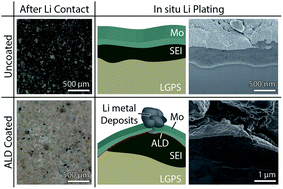当前位置:
X-MOL 学术
›
J. Mater. Chem. A
›
论文详情
Our official English website, www.x-mol.net, welcomes your
feedback! (Note: you will need to create a separate account there.)
Electro-chemo-mechanical evolution of sulfide solid electrolyte/Li metal interfaces: operando analysis and ALD interlayer effects
Journal of Materials Chemistry A ( IF 10.7 ) Pub Date : 2020/03/20 , DOI: 10.1039/c9ta11508k Andrew L. Davis 1, 2, 3, 4 , Regina Garcia-Mendez 2, 3, 4, 5 , Kevin N. Wood 1, 4, 6, 7, 8 , Eric Kazyak 1, 2, 3, 4 , Kuan-Hung Chen 2, 3, 4, 5 , Glenn Teeter 4, 6, 7 , Jeff Sakamoto 1, 2, 3, 4, 5 , Neil P. Dasgupta 1, 2, 3, 4
Journal of Materials Chemistry A ( IF 10.7 ) Pub Date : 2020/03/20 , DOI: 10.1039/c9ta11508k Andrew L. Davis 1, 2, 3, 4 , Regina Garcia-Mendez 2, 3, 4, 5 , Kevin N. Wood 1, 4, 6, 7, 8 , Eric Kazyak 1, 2, 3, 4 , Kuan-Hung Chen 2, 3, 4, 5 , Glenn Teeter 4, 6, 7 , Jeff Sakamoto 1, 2, 3, 4, 5 , Neil P. Dasgupta 1, 2, 3, 4
Affiliation

|
Sulfide solid electrolyte (SE) materials show promise for high-performance solid-state batteries because of their high ionic conductivity and ease of processing. However, several sulfide electrolytes have suffered from chemical and electrochemical instability against Li metal anodes. Herein, we use a suite of operando microscopy and spectroscopy techniques to study the impact of artificial solid electrolyte interphases (SEI) on the electro-chemo-mechanical degradation of Li10GeP2S12 (LGPS) solid electrolytes. Al2O3 interlayers deposited using atomic layer deposition (ALD) are used as a model system to show that the application of artificial SEI interlayers can delay degradation at the Li/LGPS interface by modifying the solid electrolyte interphase chemistry and morphology. Optical and scanning electron microscopy are used to rationalize the electrochemical response of the system, which is attributed to a delayed onset of mechanical degradation at the interface when ALD interlayers are used. Operando X-ray photoelectron spectroscopy demonstrates that the dynamic evolution of SEI chemistry is impacted by the presence of the ALD interlayer. Auger electron spectroscopy and operando optical microscopy provide visual evidence of spatial heterogeneity of Li plating, which is attributed to the chemo-mechanical degradation of the ALD interphase. The implications of these observations provide valuable insights toward the development of robust interlayers for solid-state batteries.
中文翻译:

硫化物固体电解质/锂金属界面的电化学机制演变:操作分析和ALD层间效应
硫化物固体电解质(SE)材料具有高离子电导率和易于加工的特性,因此有望用于高性能固态电池。然而,几种硫化物电解质对锂金属阳极遭受化学和电化学不稳定性。在这里,我们使用一整套操作显微镜和光谱技术研究人工固体电解质中间相(SEI)对Li 10 GeP 2 S 12(LGPS)固体电解质的电化学降解的影响。铝2 O 3使用原子层沉积(ALD)沉积的中间层被用作模型系统,以显示人造SEI中间层的应用可以通过修改固体电解质的相间化学和形态来延迟Li / LGPS界面处的降解。光学和扫描电子显微镜用于合理化系统的电化学响应,这归因于当使用ALD夹层时界面处机械降解的延迟开始。Operando X射线光电子能谱表明ALD中间层的存在会影响SEI化学的动态演变。俄歇电子能谱和操作光学显微镜提供了锂镀层空间异质性的视觉证据,这归因于ALD相的化学机械降解。这些发现的含义为固态电池坚固耐用中间层的开发提供了宝贵的见识。
更新日期:2020-04-01
中文翻译:

硫化物固体电解质/锂金属界面的电化学机制演变:操作分析和ALD层间效应
硫化物固体电解质(SE)材料具有高离子电导率和易于加工的特性,因此有望用于高性能固态电池。然而,几种硫化物电解质对锂金属阳极遭受化学和电化学不稳定性。在这里,我们使用一整套操作显微镜和光谱技术研究人工固体电解质中间相(SEI)对Li 10 GeP 2 S 12(LGPS)固体电解质的电化学降解的影响。铝2 O 3使用原子层沉积(ALD)沉积的中间层被用作模型系统,以显示人造SEI中间层的应用可以通过修改固体电解质的相间化学和形态来延迟Li / LGPS界面处的降解。光学和扫描电子显微镜用于合理化系统的电化学响应,这归因于当使用ALD夹层时界面处机械降解的延迟开始。Operando X射线光电子能谱表明ALD中间层的存在会影响SEI化学的动态演变。俄歇电子能谱和操作光学显微镜提供了锂镀层空间异质性的视觉证据,这归因于ALD相的化学机械降解。这些发现的含义为固态电池坚固耐用中间层的开发提供了宝贵的见识。









































 京公网安备 11010802027423号
京公网安备 11010802027423号